Premeno
Cities and towns in PiedmontMunicipalities of the Province of Verbano-Cusio-OssolaProvince of Verbano-Cusio-Ossola geography stubs

Premeno is a comune (municipality) in the Province of Verbano-Cusio-Ossola in the Italian region Piedmont, located about 130 kilometres (81 mi) northeast of Turin and about 15 kilometres (9 mi) northeast of Verbania. As of 31 December 2004, it had a population of 776 and an area of 7.4 square kilometres (2.9 sq mi).The municipality of Premeno contains the frazioni (subdivisions, mainly villages and hamlets) Esio and Pollino. Premeno borders the following municipalities: Aurano, Bee, Ghiffa, Intragna, Oggebbio, Vignone.
Excerpt from the Wikipedia article Premeno (License: CC BY-SA 3.0, Authors, Images).Premeno
Viale delle Magnolie,
Geographical coordinates (GPS) Address Website Nearby Places Show on map
Geographical coordinates (GPS)
| Latitude | Longitude |
|---|---|
| N 46.016666666667 ° | E 8.6833333333333 ° |
Address
Porto turistico Portobello
Viale delle Magnolie
28821
Piedmont, Italy
Open on Google Maps









